Abstract
To elucidate the mechanisms responsible for systemic and renal hemodynamic changes in early endotoxemia, the roles of prostaglandins (PG) and renal nerves were investigated. Endotoxin (E, 3 micrograms/kg i.v.) was given to two groups of anesthetized dogs that had undergone unilateral renal denervation: Group I (n = 9) E only; Group II (n = 11) E + indomethacin (10 mg/kg i.v.) or meclofenamate (5 mg/kg i.v.). A third group of dogs (Group III, n = 5) received indomethacin (10 mg/kg i.v.) only. 1 h after E group I dogs, mean arterial pressure (MAP) decreased from 126 to 94 mm Hg (P less than 0.001), and prostacyclin (6-keto-Fl alpha metabolite, PGI2) increased (from 0.64 to 2.08 ng/ml, P less than 0.005). Glomerular filtration rate (GFR) and renal blood flow (RBF) declined comparably both in innervated and denervated kidneys. In marked contrast, group II dogs had a stable MAP (136-144 mm Hg, NS) and no increase in PGI2 levels. Plasma renin activity (0.7-2.5 ng/ml per h, P less than 0.005) increased, and renin secretion was greater in innervated compared with denervated kidneys (255 vs. 74 U/min, P less than 0.01) in these PG-inhibited dogs. In addition, denervated kidneys in group II dogs had a greater GFR (42 vs. 34 ml/min, P less than 0.01) and RFB (241 vs. 182 ml/min, P less than 0.01) than innervated kidneys after E. Group III animals had no significant changes in systemic or renal hemodynamics, plasma renin activity or PGI2 during the study. These results suggest that PGI2 mediates the systemic hypotension of early endotoxemia in the PG-intact animal. Moreover, PG inhibition uncovers an important effect of E to increase efferent renal nerve activity with a consequent decline in GFR and RBF independent of changes in MAP. Finally, the results demonstrate that renal nerves are important stimuli to renin secretion in early endotoxemia via pathways that are PG-independent.
Full text
PDF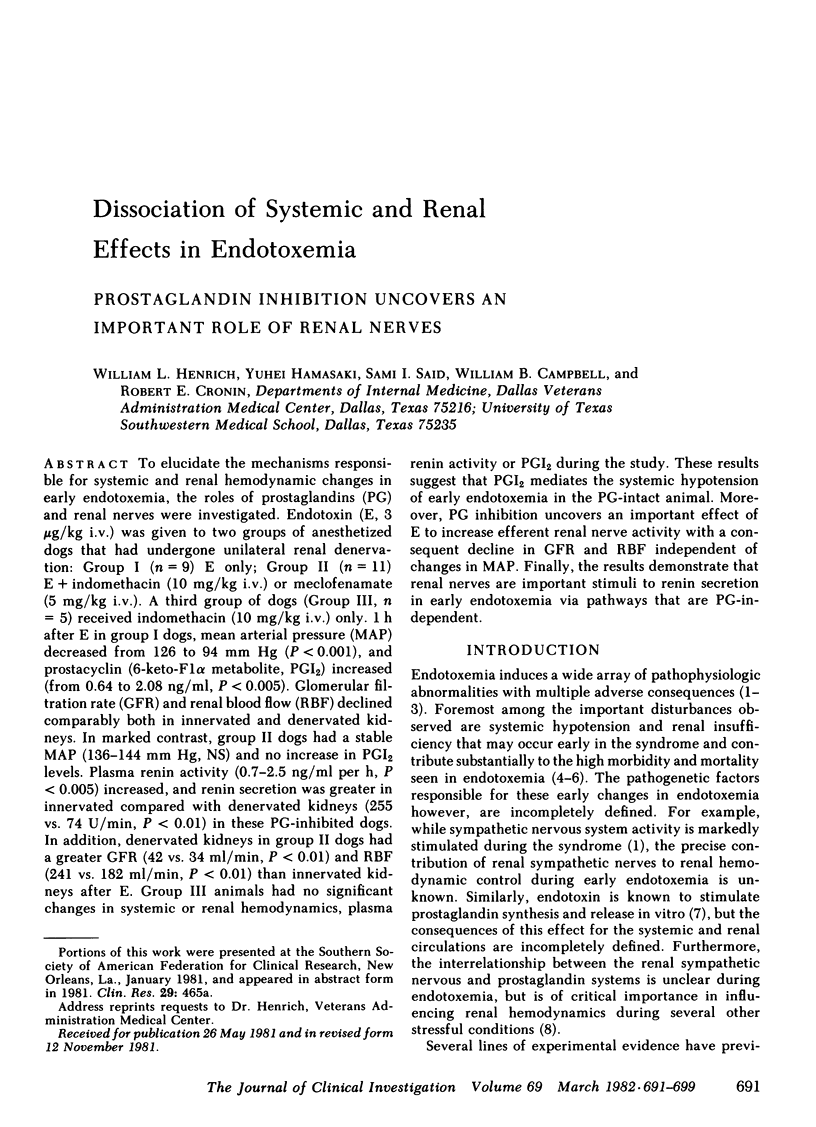
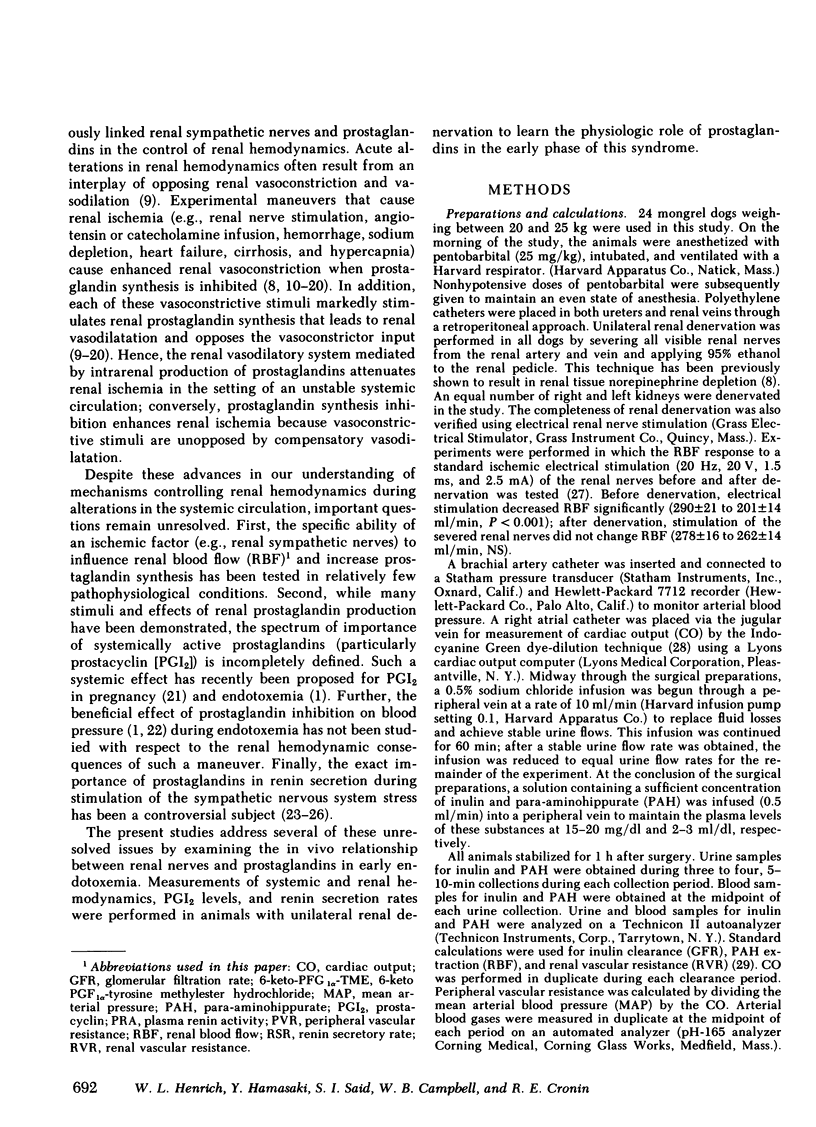
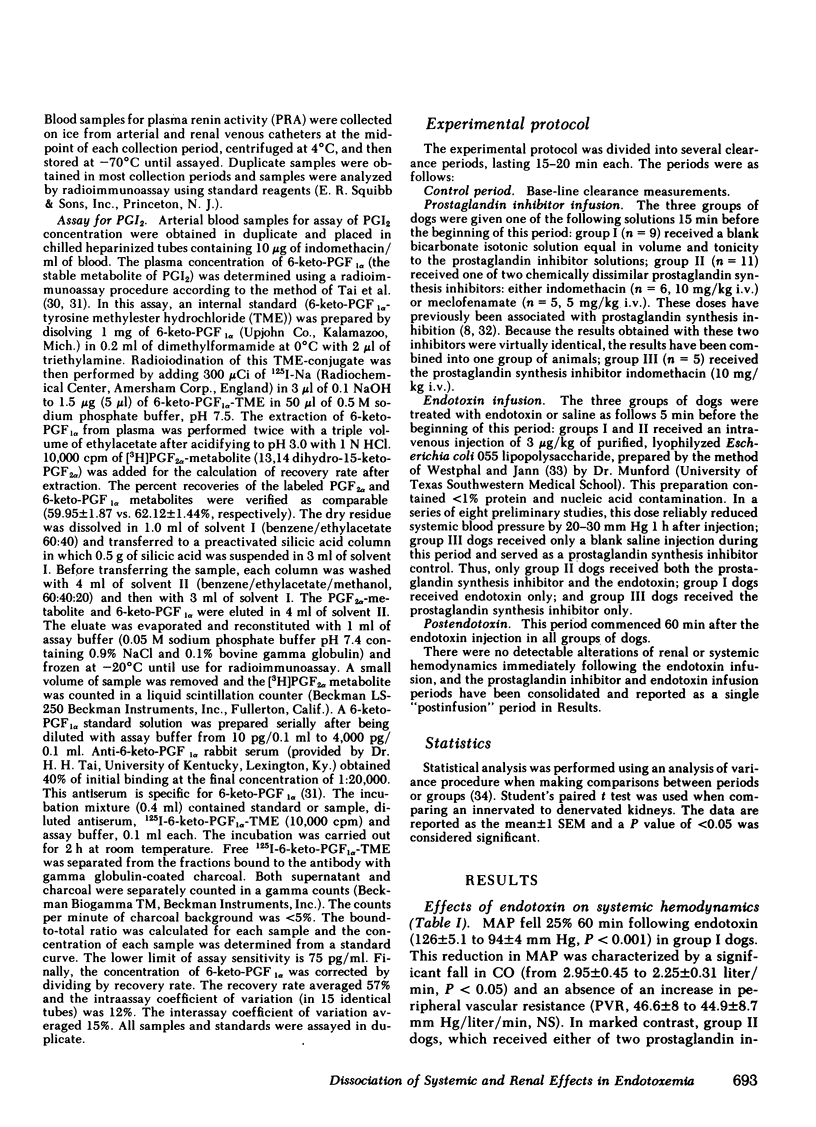
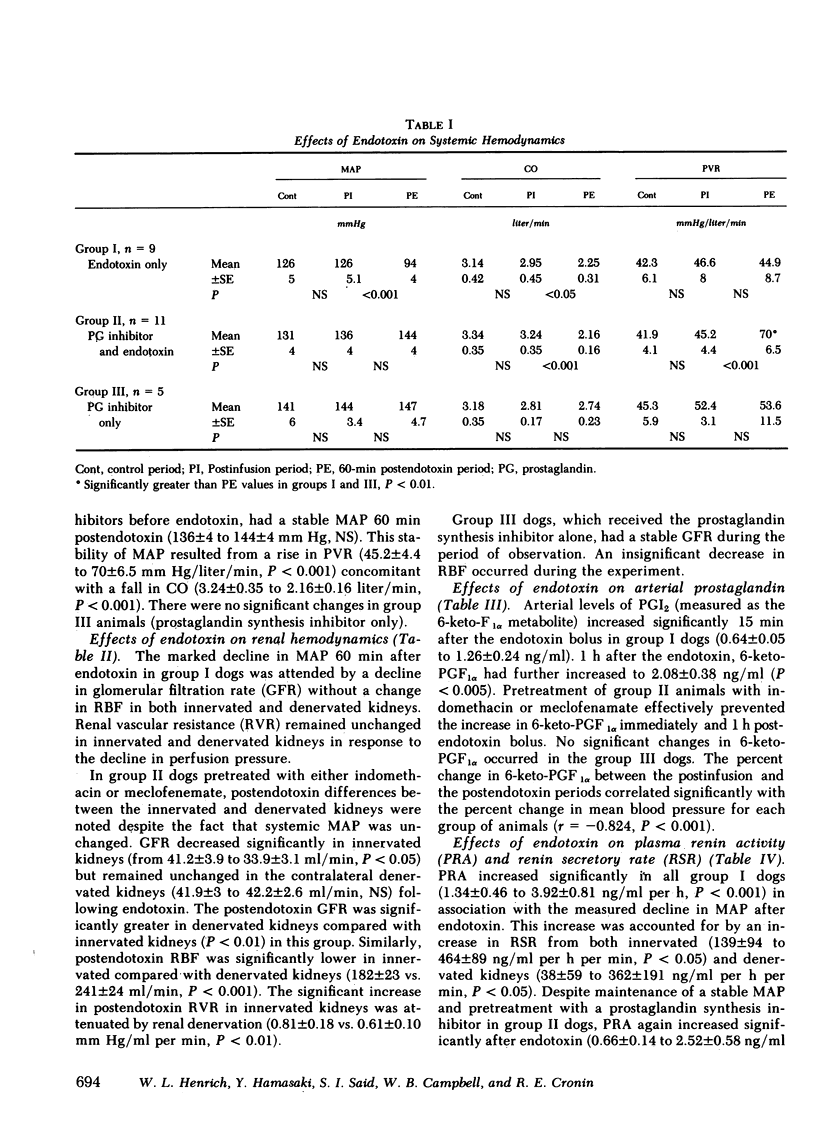
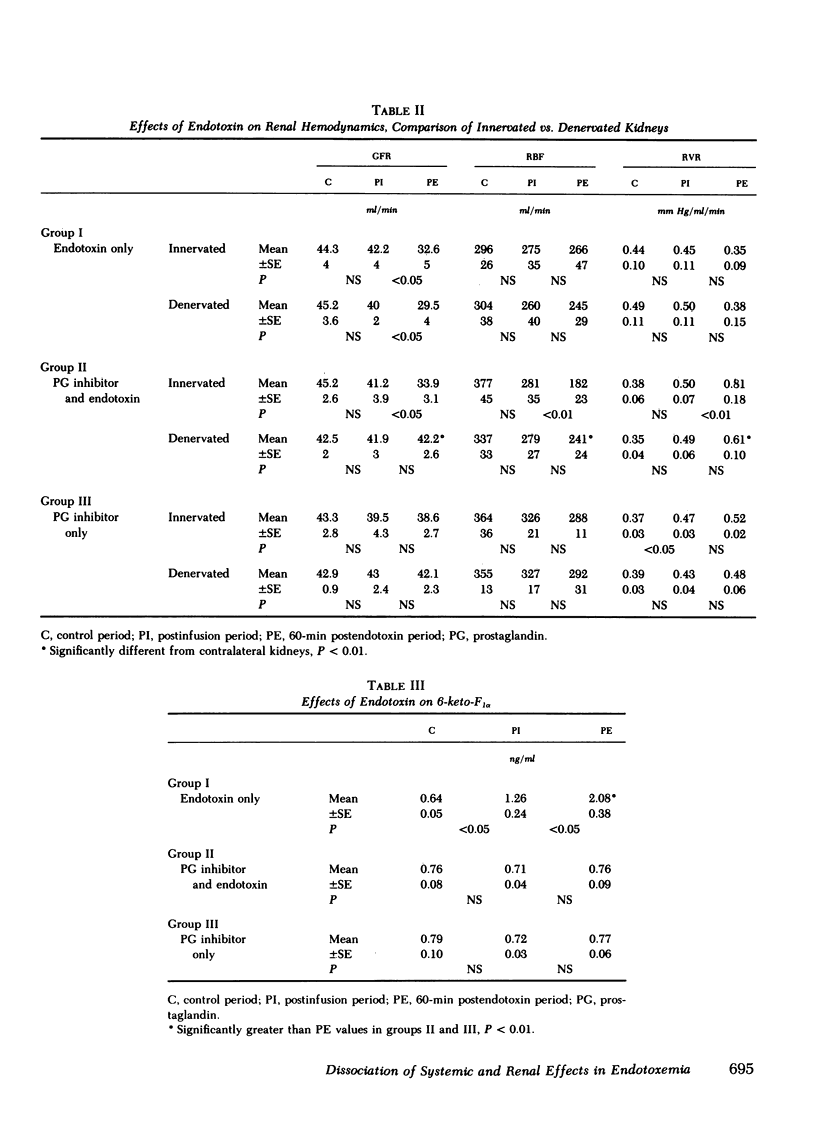
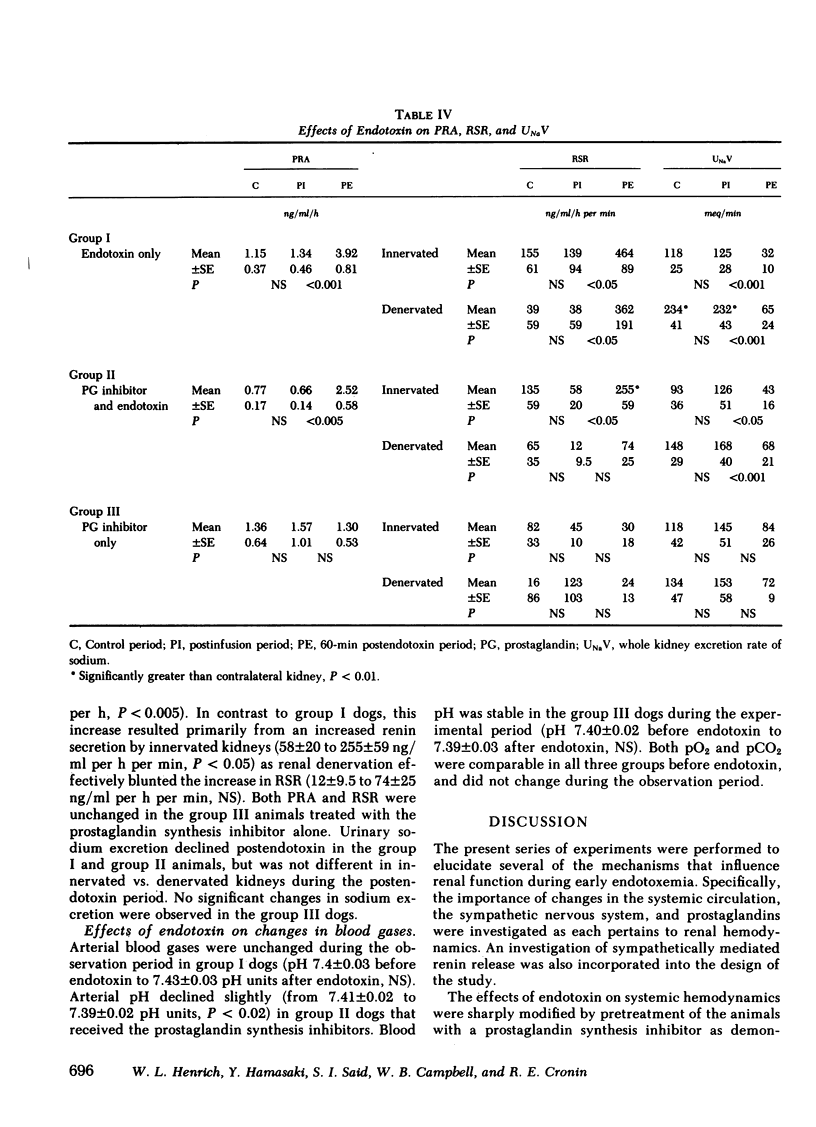
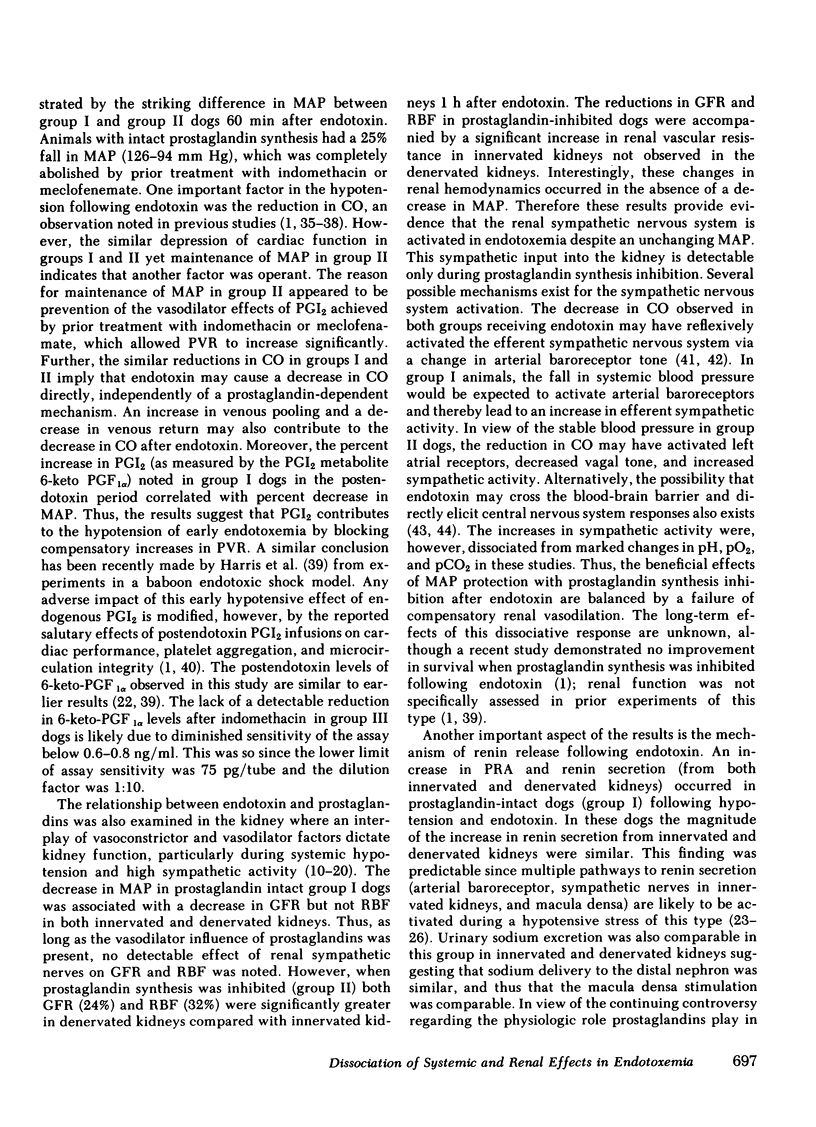
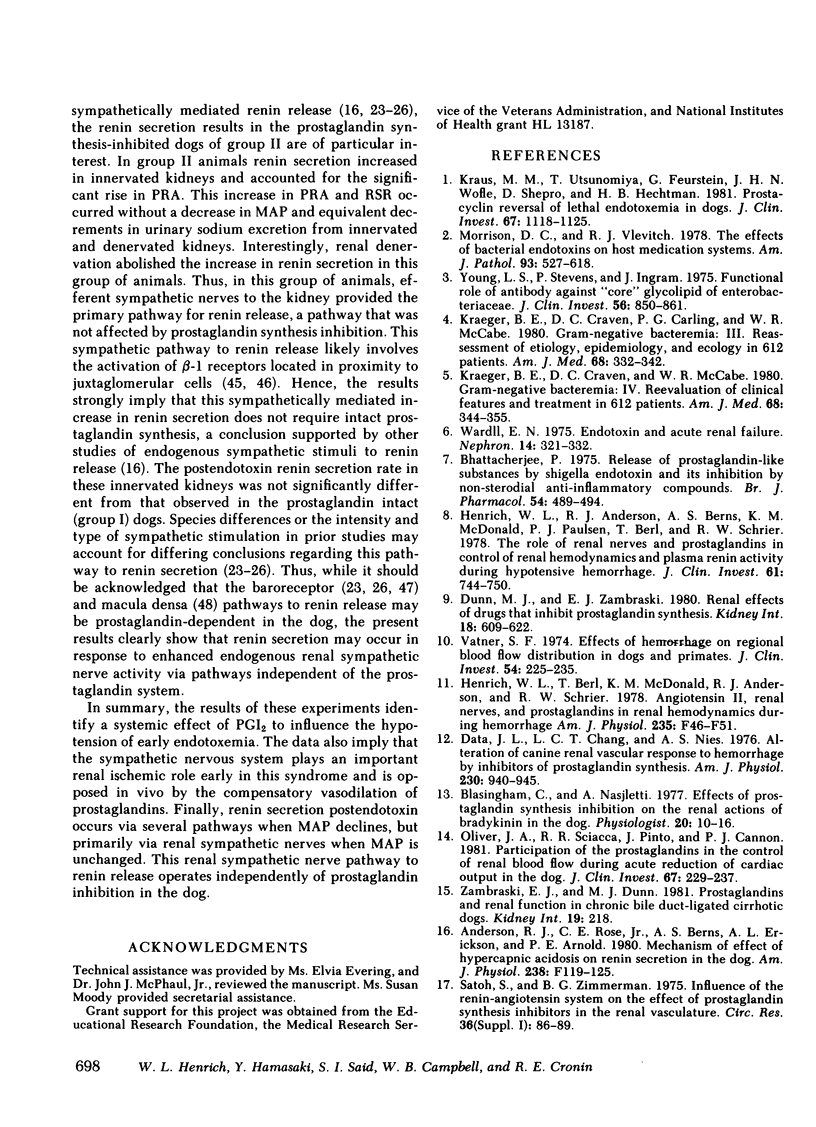
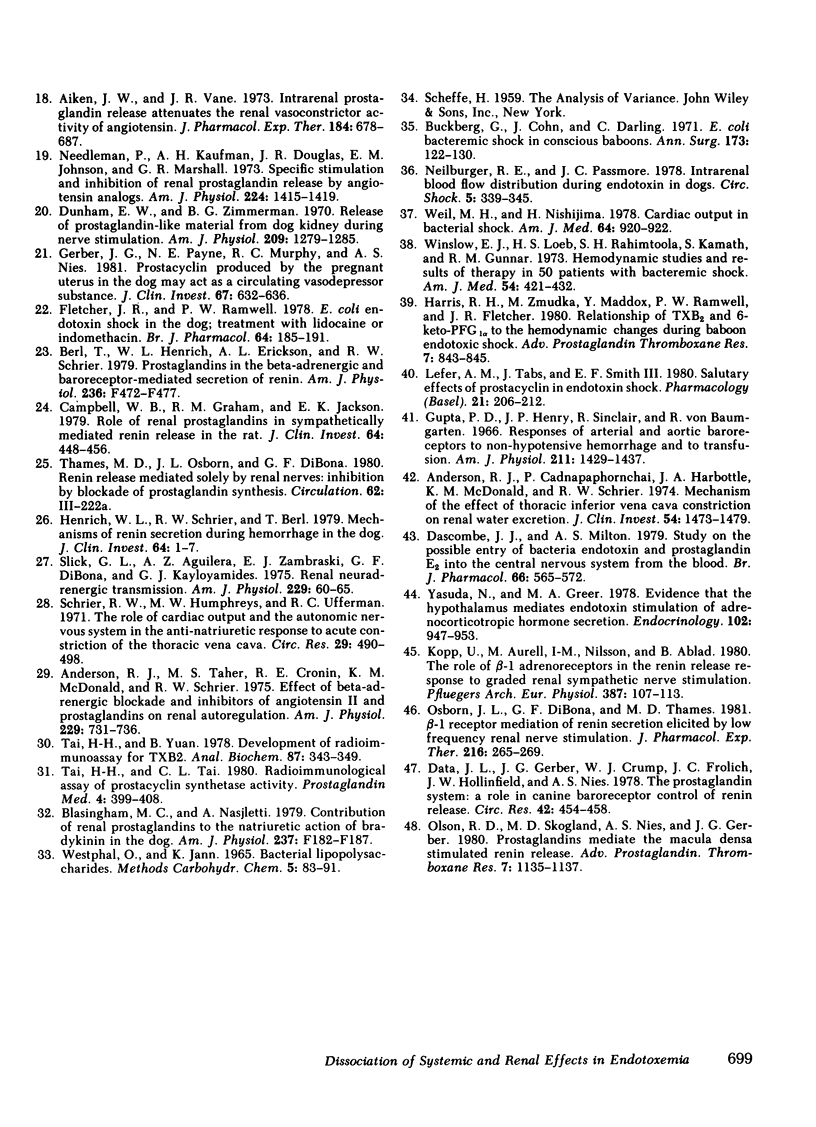
Selected References
These references are in PubMed. This may not be the complete list of references from this article.
- Aiken J. W., Vane J. R. Intrarenal prostaglandin release attenuates the renal vasoconstrictor activity of angiotensin. J Pharmacol Exp Ther. 1973 Mar;184(3):678–687. [PubMed] [Google Scholar]
- Anderson R. J., Cadnapaphornchai P., Harbottle J. A., McDonald K. M., Schrier R. W. Mechanism of effect of thoracic inferior vena cava constriction on renal water excretion. J Clin Invest. 1974 Dec;54(6):1473–1479. doi: 10.1172/JCI107895. [DOI] [PMC free article] [PubMed] [Google Scholar]
- Anderson R. J., Rose C. E., Jr, Berns A. S., Erickson A. L., Arnold P. E. Mechanism of effect of hypercapnic acidosis on renin secretion in the dog. Am J Physiol. 1980 Feb;238(2):F119–F125. doi: 10.1152/ajprenal.1980.238.2.F119. [DOI] [PubMed] [Google Scholar]
- Anderson R. J., Taher M. S., Cronin R. E., McDonald K. M., Schrier R. W. Effect of beta-adrenergic blockade and inhibitors of angiotensin II and prostaglandins on renal autoregulation. Am J Physiol. 1975 Sep;229(3):731–736. doi: 10.1152/ajplegacy.1975.229.3.731. [DOI] [PubMed] [Google Scholar]
- Berl T., Henrich W. L., Erickson A. L., Schrier R. W. Prostaglandins in the beta-adrenergic and baroreceptor-mediated secretion of renin. Am J Physiol. 1979 May;236(5):F472–F477. doi: 10.1152/ajprenal.1979.236.5.F472. [DOI] [PubMed] [Google Scholar]
- Bhattacherjee P. Release of prostaglandin-like substances by Shigella endotoxin and its inhibition by non-steroidal anti-inflammatory compounds. Br J Pharmacol. 1975 Aug;54(4):489–494. doi: 10.1111/j.1476-5381.1975.tb07595.x. [DOI] [PMC free article] [PubMed] [Google Scholar]
- Blasingham M. C., Nasjletti A. Contribution of renal prostaglandins to the natriuretic action of bradykinin in the dog. Am J Physiol. 1979 Sep;237(3):F182–F187. doi: 10.1152/ajprenal.1979.237.3.F182. [DOI] [PubMed] [Google Scholar]
- Buckberg G., Cohn J., Darling C. Escherichia coli bacteremic shock in conscious baboons. Ann Surg. 1971 Jan;173(1):122–130. doi: 10.1097/00000658-197101000-00018. [DOI] [PMC free article] [PubMed] [Google Scholar]
- Campbell W. B., Graham R. M., Jackson E. K. Role of renal prostaglandins in sympathetically mediated renin relase in the rat. J Clin Invest. 1979 Aug;64(2):448–456. doi: 10.1172/JCI109482. [DOI] [PMC free article] [PubMed] [Google Scholar]
- Dascombe M. J., Milton A. S. Study on the possible entry of bacterial endotoxin and prostaglandin E2 into the central nervous system from the blood. Br J Pharmacol. 1979 Aug;66(4):565–572. doi: 10.1111/j.1476-5381.1979.tb13695.x. [DOI] [PMC free article] [PubMed] [Google Scholar]
- Data J. L., Chang L. C., Nies A. S. Alteration of canine renal vascular response to hemorrhage by inhibitors of prostaglandin synthesis. Am J Physiol. 1976 Apr;230(4):940–945. doi: 10.1152/ajplegacy.1976.230.4.940. [DOI] [PubMed] [Google Scholar]
- Data J. L., Gerber J. G., Crump W. J., Frölich J. C., Hollifield J. W., Nies A. S. The prostaglandin system. A role in canine baroreceptor control of renin release. Circ Res. 1978 Apr;42(4):454–458. doi: 10.1161/01.res.42.4.454. [DOI] [PubMed] [Google Scholar]
- Diamond J. M. Twenty-first Bowditch lecture. The epithelial junction: bridge, gate, and fence. Physiologist. 1977 Feb;20(1):10–18. [PubMed] [Google Scholar]
- Dunham E. W., Zimmerman B. G. Release of prostaglandin-like material from dog kidney during nerve stimulation. Am J Physiol. 1970 Nov;219(5):1279–1285. doi: 10.1152/ajplegacy.1970.219.5.1279. [DOI] [PubMed] [Google Scholar]
- Dunn M. J., Zambraski E. J. Renal effects of drugs that inhibit prostaglandin synthesis. Kidney Int. 1980 Nov;18(5):609–622. doi: 10.1038/ki.1980.179. [DOI] [PubMed] [Google Scholar]
- Fletcher J. R., Ramwell P. W. E. coli endotoxin shock in the dog; treatment with lidocaine or indomethacin. Br J Pharmacol. 1978 Oct;64(2):185–191. doi: 10.1111/j.1476-5381.1978.tb17288.x. [DOI] [PMC free article] [PubMed] [Google Scholar]
- Gerber J. G., Payne N. A., Murphy R. C., Nies A. S. Prostacyclin produced by the pregnant uterus in the dog may act as a circulating vasodepressor substance. J Clin Invest. 1981 Mar;67(3):632–636. doi: 10.1172/JCI110077. [DOI] [PMC free article] [PubMed] [Google Scholar]
- Gupta P. D., Henry J. P., Sinclair R., Von Baumgarten R. Responses of atrial and aortic baroreceptors to nonhypotensive hemorrhage and to tranfusion. Am J Physiol. 1966 Dec;211(6):1429–1437. doi: 10.1152/ajplegacy.1966.211.6.1429. [DOI] [PubMed] [Google Scholar]
- Harris R. H., Zmudka M., Maddox Y., Ramwell P. W., Fletcher J. R. Relationship of TXB2 and 6-keto PGF1 alpha to the hemodynamic changes during baboon endotoxic shock. Adv Prostaglandin Thromboxane Res. 1980;7:843–849. [PubMed] [Google Scholar]
- Henrich W. L., Anderson R. J., Berns A. S., McDonald K. M., Paulsen P. J., Berl T., Schrier R. W. The role of renal nerves and prostaglandins in control of renal hemodynamics and plasma renin activity during hypotensive hemorrhage in the dog. J Clin Invest. 1978 Mar;61(3):744–750. doi: 10.1172/JCI108988. [DOI] [PMC free article] [PubMed] [Google Scholar]
- Henrich W. L., Berl T., McDonald K. M., Anderson R. J., Schrier R. W. Angiotensin II, renal nerves, and prostaglandins in renal hemodynamics during hemorrhage. Am J Physiol. 1978 Jul;235(1):F46–F51. doi: 10.1152/ajprenal.1978.235.1.F46. [DOI] [PubMed] [Google Scholar]
- Henrich W. L., Schrier R. W., Berl T. Mechanisms of renin secretion during hemorrhage in the dog. J Clin Invest. 1979 Jul;64(1):1–7. doi: 10.1172/JCI109427. [DOI] [PMC free article] [PubMed] [Google Scholar]
- Kopp U., Aurell M., Nilsson I. M., Ablad B. The role of beta-1-adrenoceptors in the renin release response to graded renal sympathetic nerve stimulation. Pflugers Arch. 1980 Sep;387(2):107–113. doi: 10.1007/BF00584260. [DOI] [PubMed] [Google Scholar]
- Krausz M. M., Utsunomiya T., Feuerstein G., Wolfe J. H., Shepro D., Hechtman H. B. Prostacyclin reversal of lethal endotoxemia in dogs. J Clin Invest. 1981 Apr;67(4):1118–1125. doi: 10.1172/JCI110125. [DOI] [PMC free article] [PubMed] [Google Scholar]
- Kreger B. E., Craven D. E., Carling P. C., McCabe W. R. Gram-negative bacteremia. III. Reassessment of etiology, epidemiology and ecology in 612 patients. Am J Med. 1980 Mar;68(3):332–343. doi: 10.1016/0002-9343(80)90101-1. [DOI] [PubMed] [Google Scholar]
- Kreger B. E., Craven D. E., McCabe W. R. Gram-negative bacteremia. IV. Re-evaluation of clinical features and treatment in 612 patients. Am J Med. 1980 Mar;68(3):344–355. doi: 10.1016/0002-9343(80)90102-3. [DOI] [PubMed] [Google Scholar]
- Lefer A. M., Tabas J., Smith E. F., 3rd Salutary effects of prostacyclin in endotoxic shock. Pharmacology. 1980;21(3):206–212. doi: 10.1159/000137434. [DOI] [PubMed] [Google Scholar]
- Needleman P., Kauffman A. H., Douglas J. R., Jr, Johnson E. M., Jr, Marshall G. R. Specific stimulation and inhibition of renal prostaglandin release by angiotensin analogs. Am J Physiol. 1973 Jun;224(6):1415–1419. doi: 10.1152/ajplegacy.1973.224.6.1415. [DOI] [PubMed] [Google Scholar]
- Neiberger R. E., Passmore J. C. Intrarenal blood flow distribution during endotoxemia in dogs. Circ Shock. 1978;5(4):339–345. [PubMed] [Google Scholar]
- Oliver J. A., Sciacca R. R., Pinto J., Cannon P. J. Participation of the prostaglandins in the control of renal blood flow during acute reduction of cardiac output in the dog. J Clin Invest. 1981 Jan;67(1):229–237. doi: 10.1172/JCI110018. [DOI] [PMC free article] [PubMed] [Google Scholar]
- Olson R. D., Skoglund M. L., Nies A. S., Gerber J. G. Prostaglandins mediate the macula densa stimulated renin release. Adv Prostaglandin Thromboxane Res. 1980;7:1135–1137. [PubMed] [Google Scholar]
- Osborn J. L., DiBona G. F., Thames M. D. Beta-1 receptor mediation of renin secretion elicited by low-frequency renal nerve stimulation. J Pharmacol Exp Ther. 1981 Feb;216(2):265–269. [PubMed] [Google Scholar]
- Satoh S., Zimmerman B. G. Influence of the renin-angiotensin system on the effect of prostaglandin synthesis inhibitors in the renal vasculature. Circ Res. 1975 Jun;36(6 Suppl 1):89–96. doi: 10.1161/01.res.36.6.89. [DOI] [PubMed] [Google Scholar]
- Schrier R. W., Humphreys M. H., Ufferman R. C. Role of cardiac output and the autonomic nervous system in the antinatriuretic response to acute constriction of the thoracic superior vena cava. Circ Res. 1971 Nov;29(5):490–498. doi: 10.1161/01.res.29.5.490. [DOI] [PubMed] [Google Scholar]
- Slick G. L., Aguilera A. J., Zambraski E. J., DiBona G. F., Kaloyanides G. J. Renal neuroadrenergic transmission. Am J Physiol. 1975 Jul;229(1):60–65. doi: 10.1152/ajplegacy.1975.229.1.60. [DOI] [PubMed] [Google Scholar]
- Tai C. L., Tai H. H. Radioimmunological assay of prostacyclin synthetase activity. Prostaglandins Med. 1980 Jun;4(6):399–408. doi: 10.1016/0161-4630(80)90048-8. [DOI] [PubMed] [Google Scholar]
- Tai H. H., Yuan B. Development of radioimmunoassay for thromboxane B2. Anal Biochem. 1978 Jul 1;87(2):343–349. doi: 10.1016/0003-2697(78)90683-8. [DOI] [PubMed] [Google Scholar]
- Vatner S. F. Effects of hemorrhage on regional blood flow distribution in dogs and primates. J Clin Invest. 1974 Aug;54(2):225–235. doi: 10.1172/JCI107757. [DOI] [PMC free article] [PubMed] [Google Scholar]
- Wardle E. N. Endotoxin and acute renal failure. Nephron. 1975;14(5):321–332. doi: 10.1159/000180463. [DOI] [PubMed] [Google Scholar]
- Weil M. H., Nishjima H. Cardiac output in bacterial shock. Am J Med. 1978 Jun;64(6):920–922. doi: 10.1016/0002-9343(78)90444-8. [DOI] [PubMed] [Google Scholar]
- Winslow E. J., Loeb H. S., Rahimtoola S. H., Kamath S., Gunnar R. M. Hemodynamic studies and results of therapy in 50 patients with bacteremic shock. Am J Med. 1973 Apr;54(4):421–432. doi: 10.1016/0002-9343(73)90038-7. [DOI] [PubMed] [Google Scholar]
- Yasuda N., Greer M. A. Evidence that the hypothalamus mediates endotoxin stimulation of adrenocorticotropic hormone secretion. Endocrinology. 1978 Mar;102(3):947–953. doi: 10.1210/endo-102-3-947. [DOI] [PubMed] [Google Scholar]
- Young L. S., Stevens P., Ingram J. Functional role of antibody against "core" glycolipid of Enterobacteriaceae. J Clin Invest. 1975 Oct;56(4):850–861. doi: 10.1172/JCI108164. [DOI] [PMC free article] [PubMed] [Google Scholar]


